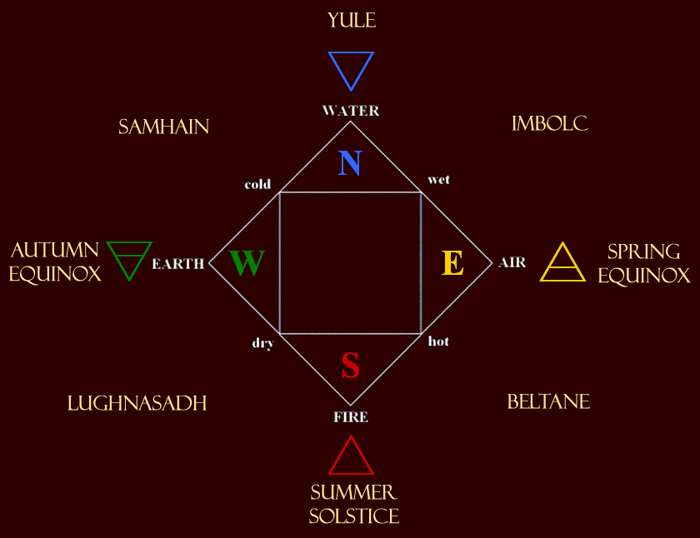
The Elements and the Seasons
- Sir Christian Henry Tobler, Grand Master, April 21, 2009 -
I often find the music I listen to, and its underlying themes
and philosophy, profoundly affects my evolving thoughts about "this thing
we do", i.e., Selohaar and its diverse activities. As I write this essay,
and the year is progressing toward mid-spring, I'm mindful of the feelings
evoked in George Winston's seasonally-themed solo piano recordings; some of
these speak to the transitions between seasons, such as his album "Winter
into Spring".
I'm also reminded of the transitions the Order makes as it continues
to expand its magical, philosophical, and martial horizons. The neo-pagan
"wheel of the year" is a good model for these transitions, and their
attendant transformations.
Before I leave the subject of music, I'll quote Robert Fripp,
visionary guitarist and chief exponent of the progressive rock group King
Crimson. In addressing the band's evolution, he wryly notes "King Crimson
is older and smaller, and continues to reinvents its wheel. When a new wheel
appears, we stand back and look at it: We have a new wheel."
While certainly not smaller, the Order is older and hopefully
still equally capable of the same innovation Mr. Fripp self-deprecatingly
lauds. And the idea of "reinventing the wheel" is especially apropos
for what I'm about to say.
At the most recent Selohaar Gather (April 4, 2009), I presented
once again, albeit with some enhancements, my seminar The Three and the
Four, a presentation describing the various correspondences of triads
and tetrads, both in Western mysticism as a whole, and in Selohaar magic and
philosophy specifically. This is, in various venues, perhaps the sixth time
I've given the presentation. Each time that I've presented it, I've wondered
afterward: what am I missing? What else is in this data that demands our use
or further study? [I'm pleased to say that I'm not the only one asking these
questions: Lady Catriona began a thread
on triads on the Selohaar Forum right after the gather.]
The answer, at least for this iteration of post-seminar thoughts,
struck me during my morning commute today. As I thought about Messrs. Winston
and Fripp, and their respective musings on wheels of different sorts, it occurred
to me that there is a level of depth left unexplored by us regarding our ritual
observation of the cycle of the seasons - the Wheel of the Year. I believe
we need, in part, to reinvent our wheel of the year, and in a way that reflects
our deepening understanding of the classical elements.
We know that the elements of Fire, Air, Water, and Earth are
given properties characterizing their individual dynamics: Fire is Hot and
Dry, Air Wet and Hot, Water Cold and Wet, and Earth Dry and Cold. Some sources
use a less intense quality of heat - warm, in lieu of hot. In any case, these
combinations of hot, cold, wet, and dry describe the four elements. They also
describe the four humors, temperaments, bodily fluids, etc. and…the four
seasons. Winter is cold and wet, corresponding to the element of Water. In
like fashion, spring is warm and wet (Air), summer is hot and dry (Fire),
and autumn is dry and cold (Earth).
Knowing this, might we not expand our use of elemental symbolism beyond our spatially-aligned invocations of the four elemental Regents? We could, and I believe should, use the appropriate element for a given seasonally-scheduled Selohaar gather's ritual. A Summer Solstice gather might particularly celebrate the element of Fire, the element associated with that season, while Yule could include some themes structured around the element of Water.
But how should we treat the counter-quarter holidays - Imbolc
(February), Beltane (May), Lughnasadh (August), and Samhain
(November)? Here is where Mr. Winston's seasonal transition "Winter into
Spring" comes into play, for we can understand a holiday such as Imbolc
as a time of transition between those two seasons, between Water and Air,
that is, from Cold and Wet to Wet and Hot (or warm - I can't quite bring myself
to use so extreme a term as 'hot' for spring, at least not here in New England!).
The common denominator for these two seasons is the quality of 'wetness'.
Similarly, Lughnasadh is a time of transition from summer to autumn, from
Hot and Dry (Fire) to Dry and Cold (Earth); here the common quality is 'dryness'.
If all of this seems just a little dizzying, perhaps an elemental diagram, now augmented with the holiday/gather names, will help:

The Wheel of the Year, with elemental, directional, and gather/holiday
correspondences
All of this points to the rather exciting prospect of having
more systematic and concrete terms to use in creating our seasonally-themed
rituals. This only makes sense, given our process in ritual is intended to
echo nature's process, best seen in the progress of the seasons.
I do not know, as of this writing, exactly how we might add in this additional layer of symbolism. The coming months - as the wheel continues to turn, and reinvent itself - will reveal those details, particularly once other minds in the Order turn to look at this new challenge, doubtlessly musing: We have a new wheel.
